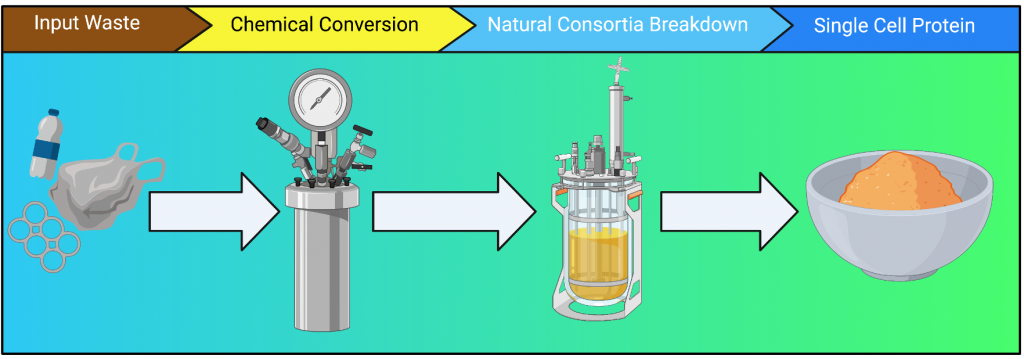Bacteria and Archaea are ubiquitous in the environment and play essential roles in the cycling of elements. These environmental microbes are capable of catalyzing a wide array of chemical reactions, many of which may have industrial applications. We are interested in how members of complex microbial communities can cooperate to perform functions of industrial interest. The majority of microbes in the environment are difficult to grow in the lab. Furthermore, many industrially-relevant pathways are found in microbes not yet grown in the lab. We seek to employ both culture-based and culture-independent methods to understand how these microbial communities respond to anthropogenic activity and environmental change and how we might leverage these microbes for a biotechnological application.
Plastic to Food
It is estimated that the world’s population will increase to near 10 billion by 2050. This increase in population requires creative solutions for feeding a growing world population. Coupled with the challenge of feeding a growing population, is that fact that every year 300 million tons of plastic waste is generated. Of this plastic waste only about 9% is recycled with the majority of plastic waste entering the environment of being disposed in a landfill. As part of this project we are working with a team of scientists to develop coupled chemical and biological methods for rapid conversion of plastic waste into valuable products such as food. While some microorganism have the ability to depolymerize plastic, this often occurs at very slow rates. To speed up the rate of biological conversion of plastics, we are coupling chemical methods for deconstruction of plastic such as pyrolysis and chemical deconstruction of plastics to break the plastic into more biodegradable compounds. These biodegradable plastic breakdown products can then be fed to a consortium of microorganisms that can further metabolize these substrates to product microbial biomass. Microbial biomass is approximately 55% protein and includes other nutritional compounds such as fatty acids, carbohydrates, and vitamins. This makes microbial biomass a potential food alternative. In developing this process we are able to develop technology to deal with societally important problems while gaining basic knowledge of microbial metabolism and microbial community dynamics. This work is funded by the DARPA ReSource Program and the Merck Future Insight Prize.
Microbial Communities as Biosensors
Microbial communities are able to rapidly respond to environmental change and anthropogenic activity. Genomic sequencing technology has enabled deep insights into microbial communities. The composition of a microbial community has the potential to be used as a biosensor of a particular phenomenon. Machine Learning applied to metagenomic and 16S rRNA data can allow for predictions of complex phenomena. We are interested in using machine learning and explainable AI to identify particular microbial taxa or genes that may be used as biosensors to be used in environmental monitoring and forensics. We are pursuing the development of rapid point-of-interest assays for biomarkers of interest to enable provenance determination and contaminant monitoring. This work is funded by the DARPA Young Faculty Award Program.
Freshwater Oil Biodegradation
Oil is routinely transported across or over many freshwater ecosystems. Oil spills have impacted a number of ecosystems including a number of freshwater environments. Microbes in these settings have the ability to degrade many of the components of oil. This was recently shown to be the case in the microbes present in the Gulf of Mexico during the Deepwater Horizon oil spill. In this case many of the marine microbes that responded to the Deepwater Horizon oil spill were well-adapted for growth under very cold temperatures. Very little is known about how microbial communities in lakes and streams would respond to released oil. Even less is known about the fate of this oil under cold temperatures. We are interested in investigating the oil biodegradation potential of freshwater microbial communities. We are also interested in the adaptation of oil degrading bacteria to cold conditions. This work was funded by internal funding from Michigan Tech.
The Environmental Impacts of Biocide Use
Biocides are routinely used in both household and industrial applications. Biocides have the potential to detrimentally impact natural ecosystems through accidental releases or though low level exposures. We are interested in better understanding the impact of biocide use on natural ecosystems. In particular, we are interested in understanding the impacts of biocides associated with hydraulic fracturing. Biocides are used in hydraulic fracturing operations as a means of controlling microbial growth and preventing biofouling of equipment. Exposure to low levels of biocides has the potential for select for biocide resistant microbes in natural systems. We are interested in characterizing the impact of biocides associated with hydraulic fracturing on selecting for both biocide and antibiotic resistance in streams impacted by hydraulic fracturing. This work is funded by the National Science Foundation.
Pathogen Genomic Surveillance
Genomic surveillance of pathogens has proven to be an integral tool for tracking the spread of pathogens and identifying variants of interest in emerging diseases. This project seeks to develop a sequencing facility and capabilities at Michigan Tech to contribute to the MI-SAPPHIRE Consortium for Pathogen Genomic Surveillance. This Consortium aims to provide rapid genomic surveillance of diverse pathogens from samples across the state of Michigan. The Techtmann lab’s role in the project is to direct the genomic sequencing facility and aid in protocol development for sequencing of pathogens from human and wildlife samples.


